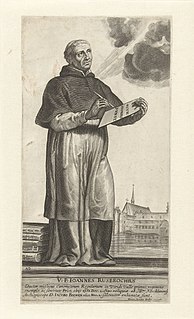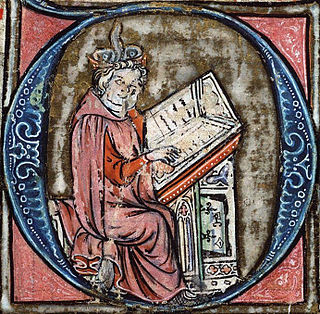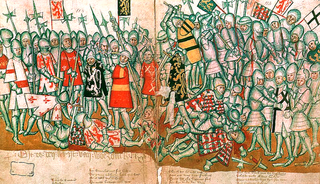This article relies largely or entirely on a single source .(September 2019) |
Lodewijk van Velthem was a Flemish poet and priest of the late 13th and early 14th century writing in Middle Dutch.
This article relies largely or entirely on a single source .(September 2019) |
Lodewijk van Velthem was a Flemish poet and priest of the late 13th and early 14th century writing in Middle Dutch.
Very little is known about the life of Lodewijk van Velthem. He was said to be from Brabant, and from descriptions of what he witnessed we can deduce that he was active before 1293 and until at least 1327. He presumably lived in Paris between 1293 and 1296. [1] In the winter of 1298, he was in Ghent. He was ordained a priest in or before 1304 as he worked as a chaplain in Zichem then. By 1312, he was the parish priest of Veltem, now a part of Herent; this is presumably the origin of his name. His earliest known writings date to this period, as the 4th part of the Spieghel Historiael was finished in 1315. [2]
After the death of Jacob van Maerlant, Van Velthem finished his most important work, the Spieghel historiael , writing the end of the 4th part and the complete 5th part. [3] In 1326, he finished the Boec van Merline, an Arthurian poem. [4]
This article contains information about the literary events and publications of the 13th century.
Vernacular literature is literature written in the vernacular—the speech of the "common people".

Lodewijk van den Berg is a Dutch-American chemical engineer, specializing in crystal growth, who flew on a 1985 Space Shuttle Challenger mission as a Payload Specialist.
Dutch language literature comprises all writings of literary merit written through the ages in the Dutch language, a language which currently has around 23 million native speakers. Dutch-language literature is the product of the Netherlands, Belgium, Suriname, the Netherlands Antilles and of formerly Dutch-speaking regions, such as French Flanders, South Africa, and Indonesia. The Dutch East Indies, as Indonesia was called under Dutch colonization, spawned a separate subsection in Dutch-language literature. Conversely, Dutch-language literature sometimes was and is produced by people originally from abroad who came to live in Dutch-speaking regions, such as Anne Frank and Kader Abdolah. In its earliest stages, Dutch-language literature is defined as those pieces of literary merit written in one of the Dutch dialects of the Low Countries. Before the 17th century, there was no unified standard language; the dialects that are considered Dutch evolved from Old Frankish. A separate Afrikaans literature started to emerge during the 19th century, and it shares the same literary roots as contemporary Dutch, as Afrikaans evolved from 17th-century Dutch. The term Dutch literature may either indicate in a narrow sense literature from the Netherlands, or alternatively Dutch-language literature.

John van Ruysbroeck, original Flemish name Jan van Ruusbroec was an Augustinian canon and one of the most important of the Flemish mystics. Some of his main literary works include The Kingdom of the Divine Lovers, The Twelve Beguines, The Spiritual Espousals, A Mirror of Eternal Blessedness, The Little Book of Enlightenment, and The Sparkling Stone. Some of his letters also survive, as well as several short sayings. He wrote in the Dutch vernacular, the language of the common people of the Low Countries, rather than in Latin, the language of the Catholic Church liturgy and official texts, in order to reach a wider audience.

The Potato Eaters is an oil painting by Dutch artist Vincent van Gogh painted in April 1885 in Nuenen, Netherlands. It is in the Van Gogh Museum in Amsterdam. The original oil sketch of the painting is at the Kröller-Müller Museum in Otterlo, and he also made lithographs of the image, which are held in collections including the Museum of Modern Art in New York City. The painting is considered to be one of Van Gogh's masterpieces.

Jacob van Maerlant was a Flemish poet of the 13th century and one of the most important Middle Dutch authors during the Middle Ages.
Flemish literature is literature from Flanders, historically a region comprising parts of present-day Belgium, France and the Netherlands. Until the early 19th century, this literature was regarded as an integral part of Dutch literature. After Belgium became independent from the Netherlands in 1830, the term Flemish literature acquired a narrower meaning and refers to the Dutch-language literature produced in Belgium. It remains a part of Dutch-language literature.
Middle Dutch literature (1150–1500) is the Dutch literature produced in the Low Countries from the 12th century up to the sixteenth century. It is preceded by only a few fragmentary texts existing in Old Dutch, and it was succeeded by Dutch Renaissance and Golden Age literature.

Lodewijk Frans Asscher is a Dutch politician and jurist who served as Leader of the Labour Party (PvdA) from 2016 to 2021 and parliamentary leader in the House of Representatives from 2017 to 2021.
Lucas Janszoon Waghenaer was a Dutch cartographer and a notable figure of the Golden Age of Netherlandish cartography, known for his pioneering contributions on the subject of nautical cartography.

The Wayana are a Carib-speaking people located in the south-eastern part of the Guiana highlands, a region divided between Brazil, Surinam, and French Guiana. In 1980, when the last census took place, the Wayana numbered some 1,500 individuals, of which 150 in Brazil, among the Apalai, 400 in Surinam, and 1,000 in French Guiana, along the Maroni River. About half of them still speak their original language.
Hendrik Herp, known in Latin as Henricus Harphius, was a Dutch or Flemish Franciscan of the Strict Observance, and a writer on mysticism.

Louis of Nassau, Lord of De Lek and Beverweerd was a Dutch soldier. He was the illegitimate son of Margaretha van Mechelen and Maurice, Prince of Orange, and so a collateral member of the House of Orange-Nassau. He was a Lord of the heerlijkheid De Lek and Beverweerd. From his father he inherited the estate of Beverweerd; and when his older brother Willem died in 1627 he inherited his estate as well.
Lodewijk Heyligen was a Flemish Benedictine monk and music theorist who served as the master of music of cardinal Giovanni Colonna in Avignon, where he became one of the closest friends of the Italian poet Petrarch. His Latin name Ludovicus Sanctus means Louis the Saint and is a literal translation of the Flemish name Lodewijk Heyligen.

The Brabantsche Yeesten is a rhyming chronicle of some 46,000 verses written in the 14th and 15th centuries in the Middle Dutch language. It provides a history of the Duchy of Brabant, and the original five volumes were written by Jan van Boendale of Antwerp; his text was later extended to seven volumes.
Moriaen is a 13th-century Arthurian romance in Middle Dutch. A 4,720-line version is preserved in the vast Lancelot-Compilatie, and a short fragment exists at the Royal Library at Brussels. The work tells the story of Morien, the Moorish son of Aglovale, one of King Arthur's Knights of the Round Table.
Lodewijk Makeblijde (1565–1630) was a Flemish Jesuit and a Renaissance poet and hymn writer.

Justus Hiddes Halbertsma, West Frisian form: Joast Hiddes Halbertsma, pron. [jo.ǝst ˈhɪdəs ˈhɔlbǝtsma] ; Dutch form: Joost Hiddes Halbertsma, pron. [joːst ˈhɪdəs ˈhalbǝrtsma], was a Frisian writer, poet, minister, lexicographer and linguist. Today, he is primarily known for the poetry and short story collection De Lapekoer fan Gabe Skroar, which he wrote with his brother Eeltsje, publishing the first edition in 1822. Afterwards, this work was continually expanded, and also came to include contributions by a third brother, Tsjalling, until all the Halbertsma Brothers' prose and poetry was posthumously collected in 1871 to become the famous work Rimen en Teltsjes. Although the literary value of this collection was later disputed by some critics, it is undeniable that Rimen en Teltsjes played a role of crucial importance in the development of a new literary tradition after Western Frisian had been used almost exclusively as a spoken language for three centuries.

Lodewijk van Schoor was a Flemish painter, draughtsman and designer of tapestries. Van Schoor was one of the major figures of Flemish tapestry design in the late 17th and early 18th century, together with Victor Honoré Janssens and Jan van Orley.